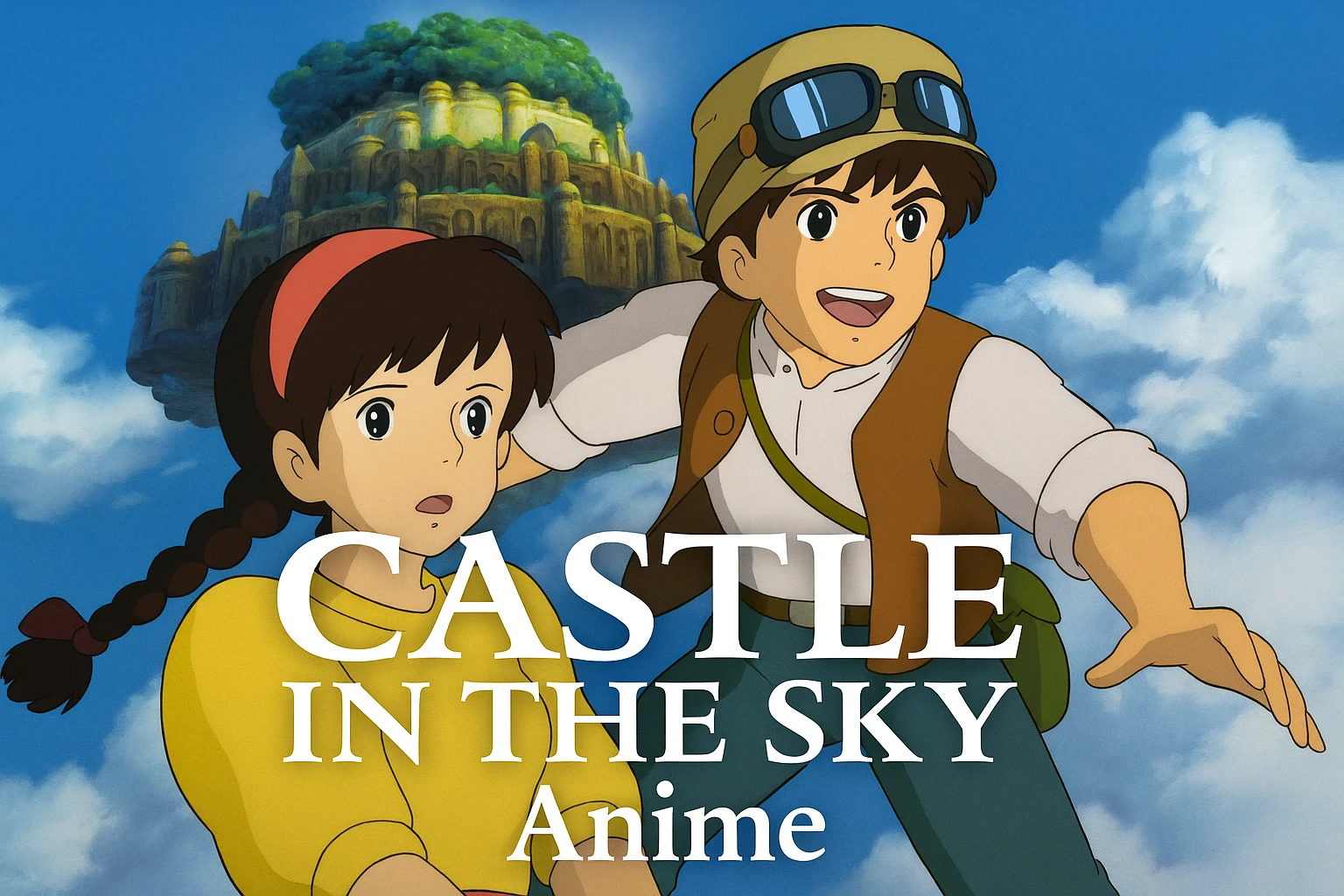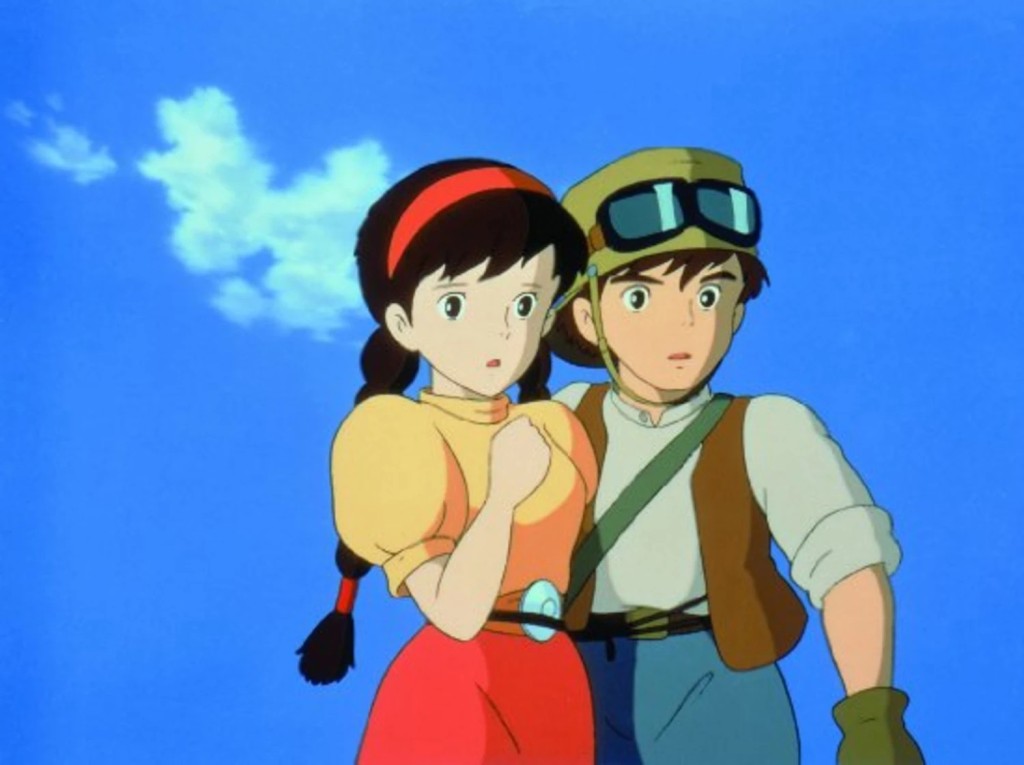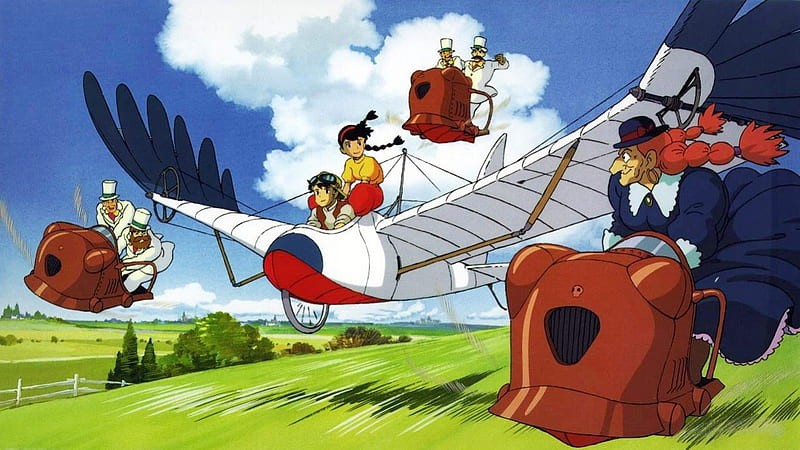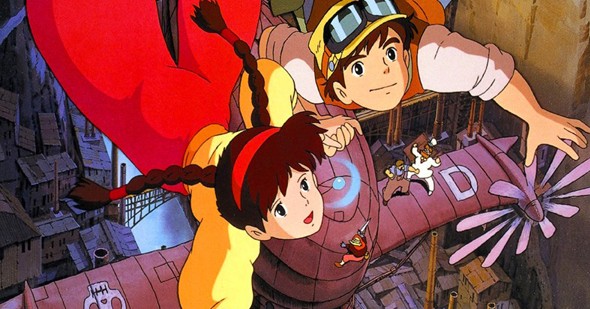
Castle in the Sky is a 1986 Japanese animated fantasy adventure film. It is directed by Hayao Miyazaki, produced by Isao Takahata, animated by Studio Ghibli, and distributed by Toei. The film follows orphans Sheeta and Pazu as they seek Sheeta's crystal necklace, the key to accessing Laputa, a legendary flying castle with advanced technology. The film was the first animated by Studio Ghibli and was inspired by Miyazaki's visits to Wales, where he witnessed the aftermath of the 1984-1985 coal miners' strike. The island of Laputa is used to highlight environmentalism, exploring the relationships between humanity, nature, and technology. The young protagonists provide a unique perspective on the narrative, reflecting Miyazaki's ecological philosophy.
The film's retro futuristic style, influenced by nineteenth-century approaches, has earned it a reputation in the modern steampunk genre. Released in Japan on August 2, 1986, it underperformed box office expectations but later achieved commercial success through rereleases, earning about US$150 million as of 2021. The film's score was composed by Joe Hisaishi, who would become a close collaborator of Miyazaki's. The film was generally acclaimed by critics, but received mixed reviews in English dubs. It was voted as one of the greatest animated films and received several notable accolades, including the Ofuji Noburo Award at the Mainichi Film Awards and the Anime Grand Prix from Animagi. Castle in the Sky has earned "cult status" and influenced several notable artists in multiple media."In this article, we’ll explore the fascinating world and key details of the anime classic Castle in the Sky."
Castle In the Sky - Plot

Sheeta, an orphan girl abducted by government agent Muska, is abducted by air pirate Dola and her gang. Sheeta falls from the airship but is saved by the magic of the now-glowing crystal. Pazu, an orphan working as a mechanic in a 19th-century mining town, takes Sheeta to his home to recover. The next morning, Pazu shows Sheeta a picture of Laputa, a mythical castle on a flying island, which Pazu now seeks. Dola's gang and Muska's soldiers arrive looking for Sheeta.
Sheeta reveals that she has a secret name tying her to Laputa, proving the myth is real. Muska releases Pazu in exchange for Sheeta guiding the army to Laputa. When Pazu returns home, Dola's gang prepares to take the crystal from the fortress. Sheeta recites an ancient phrase her mother taught her and inadvertently activates the crystal's magic, reanimating the robot. The robot protects Sheeta from the army and destroys the fortress with its weapons. However, it is destroyed in turn by the military airship Goliath. Sheeta helps Pazu convince Dola to take them there in exchange for temporarily joining her crew. That night, Sheeta and Pazu keep watch from the crow's nest as Goliath attacks Dola's airship. Dola detaches the crow's nest, which also functions as a glider attached to the ship with a line. The storm causes Goliath to destroy the airship, and Sheeta and Pazu land safely on Laputa. The castle is in ruins, and a giant tree grows out of the top of the island. The army arrives and begins looting the castle, taking Dola's gang captive. Muska and his accomplices betray the army, destroying their communication systems, and taking Sheeta into the castle's core. Pazu frees Dola's gang from their bindings and pursues Muska. The castle's core contains Laputa's ancient knowledge and weapons, which Muska uses to demonstrate Laputa's power. Sheeta teaches Pazu another ancient phrase, the spell of destruction, which sends Muska falling to his death. The giant tree preserves the rest of the castle and the island rises into space.Castle in te Sky - Voice Cast

Pazu
- Japanese (1986): Mayumi Tanaka
- English (1987, Tokuma): Barbara Goodson
- English (2003, Disney): James Van Der Beek
Sheeta
- Japanese: Keiko Yokozawa
- English (1987, Tokuma): Louise Chambell
- English (young, Tokuma): Debi Derryberry
- English (2003, Disney): Anna Paquin
Dola
- Japanese: Kotoe Hatsui
- English (1987, Tokuma): Rachel Vanowen
- English (2003, Disney): Cloris Leachman
Muska
- Japanese: Minori Terada
- English (1987, Tokuma): Jack Witte
- English (2003, Disney): Mark Hamill
General (Shogun)
- Japanese: Ichirō Nagai
- English (1987, Tokuma): Mark Richards
- English (2003, Disney): Jim Cummings
Uncle Pom
- Japanese: Fujio Tokita
- English (1987, Tokuma): Fujio Tokita
- English (2003, Disney): Richard Dysart
Mr. Duffi / Boss (Oyakata)
- Japanese: Hiroshi Ito
- English (1987, Tokuma): Charles Wilson
- English (2003, Disney): John Hostetter
Charles
- Japanese: Takuzō Kamiyama
- English (1987, Tokuma): Bob Stuart
- English (2003, Disney): Michael McShane
Henri
- Japanese: Sukekiyo Kameyama
- English (1987, Tokuma): Eddie Frierson
- English (2003, Disney): Andy Dick
Louis
- Japanese: Yoshito Yasuhara
- English (1987, Tokuma): Unknown
- English (2003, Disney): Mandy Patinkin
Sheeta's Mother (Okami)
- Japanese: Machiko Washio
- English (1987, Tokuma): Tress MacNeille
Madge
- Japanese: Tarako Isono
- English (1987, Tokuma): Debi Derryberry
Motro / Old Engineer
- Japanese: Ryūji Saikachi
- English (1987, Tokuma): Eddie Frierson
Train Operator
- Japanese: Tomomichi Nishimura
- English (2003, Disney): Matt K. Miller
Castle in the Sky - Development

After the commercial success of his previous film, Nausicaä of the Valley of the Wind (1984), Miyazaki was eager to create an old-fashioned adventure film. His first proposal for an animated feature film was based on a research trip to Yanagawa, tentatively titled "Blue Mountains." This inspired Isao Takahata to create The Story of Yanagawa's Canals (1987), a documentary on the environmental effects of industry on local waterways. Animage editor Toshio Suzuki recommended directing another film to recover the expense, and Miyazaki agreed.
They developed a concept for the film based on an idea he had in elementary school. In 1985, Miyazaki and Takahata founded Studio Ghibli, with support from Suzuki and Tokuma Shoten. The studio's intent was to "blow a whirlwind" into the stagnating Japanese animation industry by creating original, high-quality feature films. Suzuki stated that the studio would dedicate full energy to each piece of work with sufficient budget and time, never compromising on the quality or content.
In 1985, Miyazaki visited Wales during the early stages of Castle in the Sky production, drawing inspiration from the region's architecture and the aftermath of the coal miners' strike. His experiences influenced the film's supporting characters, who despite poverty, heroically protect the protagonists from multiple aggressors. This depiction reflects Miyazaki's yearning for a simpler way of life and a desire to create a story based on optimism. Animation scholar Helen McCarthy suggests that Castle in the Sky contains echoes of the struggle of the Welsh people for nationhood and freedom.
Production of the film involved a combination of cel and film techniques, with Takahata insisting on maintaining the highest quality despite production expenses. Miyazaki stated in the original project proposal that the film aimed to bring animation back to its roots. The film had a reported production budget of ¥500 million, equivalent to US$8 million in 2023, with animation studios like Doga Kobo and Oh! Production providing support for the in-between animation.Themes
Castle in the Sky is a film that explores the theme of environmentalism, questioning humanity's relationship with nature and the role of technology. The giant tree of Laputa is seen as a metaphor for the reviving and life-giving power of nature, but its underside symbolizes the immorality of modernity. Critics note the philosophical ambiguity of the castle, which initially appears to be an ideal union of nature and technology but is later revealed to have a harsher and more oppressive underside. The film also presents an ambiguous view on the usage of technology, with robots from Laputa being introduced as violent forces capable of extreme destruction but later becoming peaceful, tending to the gardens and fauna on Laputa. Critics argue that this is not a comment on technology but on man's inability to use it wisely. The film features young children as protagonists, who are often orphaned or separated from their parents. Miyazaki believes that one of the essential elements of most classical children's literature is that the children in the stories actually fend for themselves. The presence of parents would stifle the children's autonomy. The limitations that children have in their abilities are also explored in the film, such as Pazu coming close to forsaking Sheeta and his quest for Laputa. Napier proposes that Miyazaki's insistence on showing the freedom of children in Castle in the Sky can be credited to the influence of Panda and the Magic Serpent (1958), which he first watched at age 17. He believed that the honesty and goodness of children in his work should be a focal point in his endeavors.Style
Miyazaki's affinity for flight is repeatedly displayed in Castle in the Sky, with various fictional flying machines appearing across the film. Many of the other flying machines in the film are retrofuturistic, influenced by nineteenth-century stylistic approaches. Literary scholars Jeff VanderMeer and S. J. Chambers argue that Pazu's enthusiasm to build and work with flying machines gives the film's airships "a realistic physicality." Animation scholar Thomas Lamarre argues that the film provides an "alternative to our received technologies" and thus a critique of more contemporary technologies and society's perception of them. Many of these elements subsequently influenced the steampunk genre, with Verne's impact on the film's style evoking imagined nostalgia for a time when "machines were still fun". In conclusion, Castle in the Sky is a film that explores the themes of environmentalism, innocence, and the relationship between humans and nature.Critical Response
Castle in the Sky, an anime film by Hideaki Miyazaki, has been highly acclaimed by film critics. Animagi ranked it 44th in their top 100 anime list in 2001, and animation critic Raz Greenberg called it one of the greatest adventure films ever made. Rotten Tomatoes has an approval rate of 96% from 28 critics, with an average rating of 7.6 out of 10. Metacritic has a weighted average score of 78 out of 100 based on seven critics, indicating "generally favourable reviews."
Despite some reviewers arguing that the film's two-hour runtime would turn audiences away, others believe it has the appeal to keep audiences entertained. The characters are likable, and the 1987 English dub received mixed reviews, with some calling it "the film's weakest element" while others praised the animation. However, some felt the motions lacked fluidity. Most reviewers highlighted the imaginative capacity of Miyazaki in the film, with subtle details lending it "texture and originality". The film's dynamism, use of color, and strong ecological theme have been praised by critics. The film can present themes that are critical of modern society while maintaining a "warm and caring" view of humanity. Critics and scholars also noted the film's connections to Miyazaki's previous works, with Greenberg stating that it is "deeply rooted within Miyazaki's filmography of the two decades that preceded it" and Denison calling it a "compendium of Miyazaki's previous interests as an animator."FAQs
Q1: What is Castle in the Sky about?
A: It's a fantasy adventure anime about a young girl named Sheeta and a boy named Pazu who search for a legendary floating island called Laputa while being chased by pirates, military forces, and secret agents.
Q2: Who directed Castle in the Sky?
A: The film was written and directed by Hayao Miyazaki and produced by Studio Ghibli.
Q3: When was Castle in the Sky released?
A: It was released in Japan on August 2, 1986.
Q4: Is Castle in the Sky the first Studio Ghibli film?
A: Yes, it was the very first official film released under the Studio Ghibli name.
Q5: What is Laputa?
A: Laputa is a mysterious floating island with advanced technology and a rich, forgotten history. It is inspired by Jonathan Swift’s Gulliver’s Travels.
Q6: Who are the main characters in the movie?
A: The main characters are Sheeta (a mysterious girl with a magical crystal), Pazu (an orphan boy and mechanic), Muska (a government agent), and Dola (a pirate captain).
Q7: What is the significance of the crystal in Castle in the Sky?
A: The crystal is a Levistone, which holds magical power and is the key to accessing Laputa.
Q8: What are some of the themes explored in the film?
A: The movie explores themes like technology vs. nature, greed, war, peace, heritage, and the power of friendship.
Q9: Is the film suitable for children?
A: Yes, it is family-friendly, though there are action scenes and some emotional moments that may be intense for very young viewers.
Q10: Is there an English dub of the movie?
A: Yes, Disney released an English-dubbed version in 2003 featuring voices by James Van Der Beek, Anna Paquin, Cloris Leachman, and Mark Hamill.
Q11: Is Castle in the Sky connected to other Ghibli films?
A: While it shares similar themes and art style, it is a standalone story and not directly connected to other Ghibli works.
Q12: Where can I watch Castle in the Sky?
A: It is available on DVD, Blu-ray, and streaming platforms like HBO Max (US) and Netflix (in some regions).
Final Thoughts
Castle in the Sky, also known as Laputa: Castle in the Sky, is the second film written and directed by Hayao Miyazaki and produced by Tokuma Shoten. It is the first film created by Studio Ghibli and released on August 2, 1986. Miyazaki proposed the film after consulting Toshio Suzuki, who worked for Tokuma Shoten. The film was the first to feature Totoro's profile in the opening, despite being released before My Neighbour Totoro (1988). The film won the Animagi Anime Grand Prix in 1986 and remains one of Ghibli's most popular works to date.
A special exhibition called Laputa, The Castle in the Sky and Imaginary Science Fiction Machines was held from October 2, 2002, to May 9, 2004, at the Ghibli Museum in Mitaka, Tokyo, featuring animated shorts, Imaginary Flying Machines and The Invention of Imaginary Machines of Destruction. The film is available for streaming on Max and is also available for purchase on most digital storefronts.
https://www.myanimeforlife.com/castle-in-the-sky/?feed_id=137859&_unique_id=68431a0b7b619
Comments
Post a Comment